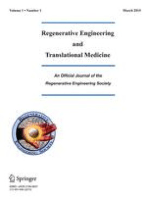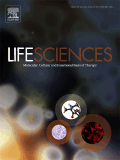
Inflammation and Regeneration
Scope & Guideline
Connecting researchers to the latest in inflammation and regeneration.
Introduction
Aims and Scopes
- Neuro-immune interactions:
Research focusing on the interplay between the nervous and immune systems, particularly how neuro-immune crosstalk can influence regeneration and inflammation in conditions such as neurodegenerative diseases. - Stem cell and regenerative therapies:
Emphasis on the use of stem cells, including mesenchymal stem cells and induced pluripotent stem cells (iPSCs), for therapeutic applications in regeneration and treatment of inflammatory diseases. - Extracellular vesicles and their roles:
Investigation into the role of extracellular vesicles in mediating cellular communication, inflammation, and regeneration, highlighting their potential as biomarkers and therapeutic agents. - Molecular and cellular mechanisms of inflammation:
In-depth studies on the molecular signaling pathways and cellular interactions that govern inflammatory responses and tissue regeneration across different organ systems. - Clinical applications and translational research:
Focus on translating basic research findings into clinical applications, particularly in the context of autoimmune diseases, chronic inflammation, and regenerative medicine.
Trending and Emerging
- Precision medicine and personalized therapies:
Growing focus on tailoring treatments based on individual patient profiles, particularly in autoimmune and inflammatory diseases, indicating a shift towards more personalized approaches in clinical practice. - Interactions between gut microbiota and inflammation:
Emerging interest in how gut microbiota influence inflammatory processes and regeneration, reflecting the recognition of the gut-skin and gut-liver axes and their implications for health. - Innovations in gene editing and regenerative immunotherapy:
Increased exploration of gene editing technologies, such as CRISPR, for enhancing immune responses and regenerative capabilities, indicating a rising trend in utilizing genetic tools for therapeutic purposes. - Role of epigenetics in inflammation and regeneration:
Heightened attention to how epigenetic modifications influence inflammation and regenerative processes, suggesting a deeper understanding of the molecular underpinnings of these phenomena. - Multi-omics approaches:
Integration of various omics technologies to provide comprehensive insights into the mechanisms of inflammation and regeneration, showcasing the trend towards holistic, systems-level analyses.
Declining or Waning
- Traditional inflammatory disease models:
There appears to be a reduced emphasis on classical models of inflammation, as newer methodologies and technologies, such as single-cell analyses and advanced imaging techniques, gain traction. - Generalized anti-inflammatory therapies:
Research focused on broad-spectrum anti-inflammatory treatments is less prominent, possibly due to a shift towards more targeted therapies that consider specific pathways and mechanisms. - Static studies of inflammation:
Studies that do not incorporate dynamic or real-time analyses of inflammation and regeneration are becoming less common, as the field increasingly values insights from in vivo imaging and temporal assessments.
Similar Journals

Cell Regeneration
Exploring the Future of Regenerative BiologyCell Regeneration, published by SPRINGERNATURE, stands at the forefront of biological research, focusing on the dynamic field of cellular development and regenerative biology. Since its establishment in 2012, this journal has embraced an Open Access model, facilitating widespread dissemination of key findings and fostering collaboration among researchers in the Netherlands and beyond. With an impact factor underscoring its significance, Cell Regeneration is positioned in the Q2 category in both Cell Biology and Developmental Biology as of 2023, ranked #32 out of 82 and #170 out of 285 in relevant Scopus peer fields. The journal encompasses a broad spectrum of research that advances our understanding of cellular processes, offering vital insights into regenerative mechanisms and their applications in therapies. This robust platform not only serves as a valuable resource for researchers, professionals, and students but also encourages scholarly dialogue and innovation in the fast-evolving landscape of cell biology.

Regenerative Engineering and Translational Medicine
Pioneering Insights in Regenerative HealthRegenerative Engineering and Translational Medicine is an esteemed academic journal published by Springer Heidelberg, focusing on the interdisciplinary fields of biomaterials, biomedical engineering, and cell biology. With an ISSN of 2364-4133 and an E-ISSN of 2364-4141, the journal has carved a niche for itself since its inception in 2015, showcasing cutting-edge research that bridges the gap between scientific findings and practical applications in regenerative medicine. As a recognized platform in its field, it is currently positioned within Q3 quartiles in biomaterials, biomedical engineering, and medicine (miscellaneous), with a Scopus ranking that reflects its growing influence among peers. The journal aims to disseminate high-quality, peer-reviewed articles that highlight advancements in regenerative engineering, further advancing both theoretical and applied research. Scholars and practitioners seeking to stay at the forefront of the ever-evolving landscape of regenerative health solutions will find invaluable insights and innovations within these pages. Join a community of leading thinkers and explore the journal's comprehensive research contributions, which are crucial for fostering partnerships between academia and industry in the quest for transformative medical solutions.

Tissue Engineering and Regenerative Medicine
Shaping Tomorrow’s Medical Breakthroughs TodayTissue Engineering and Regenerative Medicine, published by the Korean Tissue Engineering Regenerative Medicine Society, is a distinguished journal focusing on the interdisciplinary fields of tissue engineering, regenerative medicine, and related biomedical innovations. With an ISSN of 1738-2696 and an E-ISSN of 2212-5469, this journal disseminates cutting-edge research and advancements pivotal to developing therapeutic strategies that improve tissue function and repair. As a testament to its scholarly impact, it holds a Q2 ranking in both Biomedical Engineering and Medicine (miscellaneous) categories, reflecting its influence and relevance within the scientific community, particularly with a Scopus rank placing it in the 82nd percentile among similar journals. Although the journal does not offer open access, it provides vital insights and knowledge to researchers, professionals, and students involved in the quest for innovative solutions in medical science and engineering. With its convergence years extending from 2008 to 2024, the journal continues to be an essential platform for the dissemination of high-quality research that drives the field forward.

EXPERIMENTAL CELL RESEARCH
Fostering Collaboration in Cell Biology ResearchEXPERIMENTAL CELL RESEARCH is a highly respected journal published by Elsevier Inc, specializing in the dynamic and ever-evolving field of Cell Biology. With an impact factor positioned in the Q2 quartile for 2023, it ranks at the 124th position out of 285 in the Scopus Ranks, indicating a solid reputation among peers in the domains of biochemistry, genetics, and molecular biology. Since its inception in 1950, the journal has contributed significantly to the dissemination of groundbreaking research, providing a platform for studies that explore the nuances of cellular mechanisms, processes, and experimental methodologies. Although the journal currently does not offer open access, its commitment to high-quality, peer-reviewed research continues to attract submissions from leading scientists and scholars across the globe. Researchers, professionals, and students alike will find this journal an invaluable resource for keeping abreast of current developments and innovative breakthroughs in cellular science.

Stem Cells International
Fostering Collaboration in Cutting-edge Stem Cell ResearchStem Cells International is a premier open access journal published by HINDAWI LTD, focusing on the rapidly evolving field of stem cell research. With an ISSN of 1687-966X and E-ISSN 1687-9678, this journal has been a vital resource since its inception in 2010, showcasing innovative studies and breakthroughs up to 2024. Positioned in Q3 in Cell Biology and Q2 in Molecular Biology for 2023, as well as well-ranked in the Scopus database, the journal serves as an essential platform for researchers, professionals, and students dedicated to exploring the implications of stem cell technology in regenerative medicine and biological research. The open access model ensures wide accessibility, fostering collaboration and knowledge-sharing across the scientific community, making it a cornerstone in advancing the understanding and application of stem cell science.

Stem Cell Research & Therapy
Catalyzing Discoveries in Molecular MedicineStem Cell Research & Therapy is an esteemed international journal published by BMC, specializing in the rapidly advancing fields of stem cell research and regenerative therapies. Since its inception in 2010, the journal has embraced an Open Access model, ensuring that vital research is readily accessible to a global audience. With a significant impact in the scientific community, it holds Q1 quartile rankings in prestigious categories such as Biochemistry, Genetics and Molecular Biology, Cell Biology, and Molecular Medicine, highlighting its critical role in promoting groundbreaking research. The journal’s high Scopus rankings—placing it in the top echelons of its fields—reflect its commitment to publishing high-quality, peer-reviewed studies that advance our understanding of stem cell biology and therapeutic applications. Aimed at researchers, healthcare professionals, and students alike, Stem Cell Research & Therapy is an indispensable resource for those dedicated to the exploration and innovation within this transformative area of science.

CELL AND TISSUE RESEARCH
Elevating Understanding of Tissues and Cells Since 1924CELL AND TISSUE RESEARCH, published by Springer, is a premier journal dedicated to advancing the field of cell biology, histology, pathology, and forensic medicine. With a proud history dating back to its foundation in 1924 and continuing its legacy, this journal has established itself as a vital source for innovative research, facilitating the dissemination of significant findings that contribute to the understanding of cellular and tissue dynamics. Hailing from Germany, the journal exhibits an impressive standing in the academic community with a 2023 impact factor reflected in its category quartiles: Q2 in Cell Biology, Q1 in Histology, and Q1 in Pathology and Forensic Medicine. It ranks notably within multiple Scopus categories, including 32/208 in Pathology and Forensic Medicine and 13/62 in Histology, showcasing its high percentile rankings of 84th and 79th, respectively. Researchers, professionals, and students benefit from its extensive coverage and rigorous peer-review process that ensures the integrity and relevance of its published works, thus making it an essential resource in the scientific community. While it operates under a subscription model, its commitment to quality and impact makes it an indispensable journal for anyone engaged in cellular and tissue research.

Journal of Stem Cells & Regenerative Medicine
Advancing the Future of HealingThe Journal of Stem Cells & Regenerative Medicine is a leading publication dedicated to the advancing field of stem cell research and regenerative medicine. Established in India and published by JOURNAL STEM CELLS & REGENERATIVE MEDICINE, this Open Access journal has been available since 2007, providing researchers and practitioners with free and unrestricted access to high-quality articles. With an ISSN of 0973-7154, the journal is indexed in Scopus, featuring a wide array of topics and insights into biochemistry, biotechnology, cell biology, and molecular biology, as denoted by its relevant quartile rankings. This journal is committed to bridging the gap between laboratory research and clinical applications, making significant contributions to the scientific community. The convergence of innovative studies from 2010 to 2024 positions it as an invaluable resource for those looking to stay at the forefront of stem cell and regenerative medicine research.

IN VITRO CELLULAR & DEVELOPMENTAL BIOLOGY-ANIMAL
Elevating the Study of In Vitro DynamicsIN VITRO CELLULAR & DEVELOPMENTAL BIOLOGY-ANIMAL, published by SPRINGER, is a pivotal journal in the fields of cell biology and developmental biology, focusing on in vitro studies that enhance our understanding of animal cellular mechanisms and development. With an ISSN of 1071-2690 and an E-ISSN of 1543-706X, this esteemed journal offers a platform for researchers to present their findings and contribute to the body of knowledge necessary for advancements in biological sciences. As a recognized publication, it holds a 2023 category quartile of Q4 in Cell Biology and Developmental Biology, and Q3 in miscellaneous Medicine, reflecting its competitive position yet inviting critical submissions that can span multidisciplinary approaches. Though currently not open access, it serves as an essential resource for professionals, researchers, and students dedicated to unraveling the complexities of cellular processes in an ever-evolving field. The journal has been continuously published since 1986, signifying its long-standing commitment to fostering scientific discourse and innovation.

LIFE SCIENCES
Fostering innovation in pharmacology and toxicology.LIFE SCIENCES, published by PERGAMON-ELSEVIER SCIENCE LTD, is an esteemed international journal that has been advancing the field since its inception in 1962. With an ISSN of 0024-3205 and an E-ISSN of 1879-0631, it serves as a critical forum for researchers, professionals, and students within the realms of biochemistry, genetics, molecular biology, medicine, and pharmacology. Currently ranked in the Q1 category across multiple disciplines, including a remarkable 2nd rank in General Pharmacology, Toxicology, and Pharmaceutics, the journal maintains a prestigious position in academic circles, evidenced by its high impact factor and significant percentile ranks. While LIFE SCIENCES is not an open-access journal, it remains dedicated to publishing high-quality, peer-reviewed research that pushes the boundaries of knowledge and fosters innovation. With converged research interests leading into 2024, LIFE SCIENCES continues to be a pivotal resource for the dissemination of influential findings, making it an indispensable tool for those engaged in the life sciences.